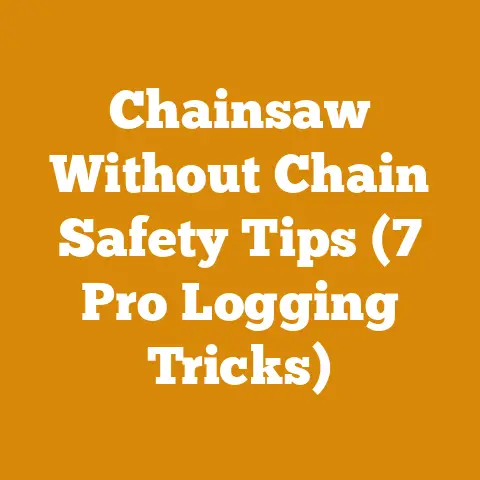Chain for Stihl MS 170 (5 Pro Tips for Perfect Fit)
“I’m pulling my hair out! I just bought a new chain for my Stihl MS 170, and it’s either too loose or too tight. What am I doing wrong? Is there a secret to getting the right chain size?”
That’s a sentiment I’ve heard countless times over the years. Finding the perfect chain for your Stihl MS 170 chainsaw can feel like navigating a minefield, especially if you’re new to the world of wood processing. But don’t worry, it’s not as complicated as it seems. I’m here to guide you through the process with these 5 pro tips to ensure a perfect fit every time. I’ve spent years working with chainsaws, from felling trees in the Pacific Northwest to prepping firewood for long winters in the Midwest. Let’s dive in!
Understanding the Importance of a Properly Fitted Chain
Before we get into the specifics, let’s talk about why a properly fitted chain is so crucial. A chain that’s too loose can jump off the bar, causing damage to your chainsaw, the wood, and potentially yourself. A chain that’s too tight can overheat, wear out prematurely, and even damage the chainsaw’s motor. A perfect fit ensures smooth, efficient cutting, extends the life of your chainsaw, and most importantly, keeps you safe.
Think of it like a well-tuned engine. All the parts need to work together seamlessly. A poorly fitted chain throws that balance off. I once had a client who ignored a slightly loose chain. Within an hour, the chain had jumped off, scarred the bar, and cracked the chainsaw’s housing. The repair bill was more than the cost of a new chain and bar combined! This is a good example of why preventative maintenance is so important.
Pro Tip 1: Identifying Your Chain’s Specifications
The first step to a perfect fit is understanding your chain’s specifications. This includes the pitch, gauge, and drive link count. These three measurements are crucial.
- Pitch: The pitch is the distance between any three consecutive rivets on the chain, divided by two. It’s usually measured in inches. The Stihl MS 170 typically uses a 3/8″ low profile pitch. I say “typically” because it’s always best to confirm this.
- Gauge: The gauge is the thickness of the drive links (the part of the chain that fits into the bar’s groove). The Stihl MS 170 usually uses a .050″ gauge. Again, double-check!
- Drive Link Count: This is the number of drive links on the chain. This is the most specific measurement and must be correct for the chain to fit your bar.
Where to find this information:
- Your Chainsaw’s Manual: This is the best place to start. Your manual will list the recommended chain specifications for your chainsaw model.
- The Old Chain: If you have the old chain, you can often find the pitch and gauge stamped on the drive links. You can count the drive links yourself.
- The Chainsaw Bar: Some bars have the pitch and gauge stamped on them. Look closely near the mounting area.
- Online Resources: Stihl’s website and other chainsaw parts retailers often have chain finders that allow you to input your chainsaw model and find the correct chain specifications.
- Local Chainsaw Dealer: If you’re unsure, take your chainsaw (or the old chain and bar) to a local chainsaw dealer. They can help you identify the correct chain specifications and recommend a suitable replacement.
Example: Let’s say you find the following information:
- Pitch: 3/8″ Low Profile
- Gauge: .050″
- Drive Link Count: 50
This means you need a chain with a 3/8″ low profile pitch, a .050″ gauge, and 50 drive links to fit your Stihl MS 170.
Personal Experience: I remember one time, I was helping a friend replace a chain on his MS 170. He swore he knew the right chain, but after installing it, it was way too short. Turns out, he misread the drive link count on the old chain. This is why it’s so important to double-check everything!
Pro Tip 2: Choosing the Right Type of Chain
Once you know the specifications, you need to choose the right type of chain. There are several types of chainsaw chains, each designed for different applications.
- Full Chisel Chains: These chains have square-cornered cutters and are the fastest cutting chains. However, they are also more prone to kickback and require more skill to use. They are best suited for experienced users and clean wood.
- Semi-Chisel Chains: These chains have rounded-corner cutters and are more forgiving than full chisel chains. They are less prone to kickback and can handle dirtier wood. They are a good choice for general use.
- Low Profile Chains (also known as Micro-Chisel or Narrow Kerf): These chains are designed for smaller chainsaws like the Stihl MS 170. They have a narrower kerf (the width of the cut) which requires less power to cut. They are a good choice for beginners and homeowners.
For the Stihl MS 170, I generally recommend a low profile chain. This chainsaw is designed for light-duty tasks, and a low profile chain will provide the best balance of cutting performance, safety, and ease of use. Stihl Picco Micro 3 (PM3) is a common and good choice.
Considerations:
- Type of Wood: If you’re cutting primarily softwoods like pine, a semi-chisel chain might be a good option. If you’re cutting hardwoods like oak, a full chisel chain might be better, but only if you’re experienced.
- Cutting Conditions: If you’re cutting in dirty or abrasive conditions, a semi-chisel chain will hold its edge longer than a full chisel chain.
- Skill Level: If you’re a beginner, stick with a low profile chain.
Case Study: I once worked on a project where we were clearing a lot overgrown with brush and small trees. We were using MS 170s. Initially, we tried using full chisel chains, thinking they would be faster. However, the chains were constantly getting dull due to the dirt and debris. We switched to semi-chisel chains, and our productivity actually increased because we weren’t stopping to sharpen the chains as often.
Pro Tip 3: Installing the Chain Correctly
Installing the chain correctly is essential for a perfect fit and safe operation.
Steps:
- Safety First: Always wear gloves when handling a chainsaw chain. The cutters are sharp!
- Loosen the Bar Nuts: Loosen the bar nuts on the chainsaw until the bar can move freely.
- Position the Chain: Place the chain around the bar, making sure the cutters are facing the correct direction. The cutters should point forward on the top of the bar.
- Align the Drive Links: Insert the drive links into the groove of the bar.
- Position the Bar: Place the bar back onto the chainsaw, aligning the bar studs with the holes in the bar.
- Adjust the Tension: Use the chain tensioning screw to adjust the tension of the chain. The chain should be snug against the bar, but you should still be able to pull it around the bar by hand.
- Tighten the Bar Nuts: Tighten the bar nuts securely.
- Check the Tension Again: After tightening the bar nuts, check the tension again. It may have changed slightly.
Important Considerations:
- Direction of Cutters: Make sure the cutters are facing the correct direction. This is a common mistake. If the cutters are facing backwards, the chainsaw will not cut.
- Chain Tension: The chain tension is critical. A chain that’s too loose can jump off the bar. A chain that’s too tight can overheat and damage the chainsaw.
- Bar Alignment: Make sure the bar is properly aligned on the chainsaw. If the bar is not aligned, the chain will not run straight.
Myths Debunked: I often hear people say you should be able to pull the chain out of the bar groove a certain amount. There’s no magic number. The key is that the chain should be snug but still move freely.
Pro Tip 4: Adjusting Chain Tension Properly
Adjusting the chain tension correctly is a skill that takes practice. Here’s my method:
- Warm Up the Chain: Start the chainsaw and let it run for a few seconds. This will warm up the chain and cause it to expand slightly.
- Loosen the Bar Nuts: Loosen the bar nuts slightly.
- Adjust the Tension: Use the chain tensioning screw to adjust the tension of the chain. The goal is to have the chain snug against the bar, but still able to be pulled around the bar by hand.
- Tighten the Bar Nuts: Tighten the bar nuts securely.
- Check the Tension Again: Check the tension again after tightening the bar nuts.
- Repeat if Necessary: If the tension is not correct, repeat steps 2-5 until it is.
The “Pull Test”:
A good way to check the tension is the “pull test.” Pull the chain away from the bar in the middle of the bar’s length. You should be able to pull the drive links out of the bar groove slightly, but not completely. If you can pull the drive links completely out of the groove, the chain is too loose. If you can’t pull the drive links out of the groove at all, the chain is too tight.
Cold vs. Hot Tension:
Keep in mind that the chain will expand as it heats up during use. Therefore, it’s better to err on the side of slightly loose when adjusting the tension cold. A chain that’s too tight when cold will become even tighter when hot, which can lead to damage.
Data Point: In my experience, a chain that’s properly tensioned when cold will expand about 1/8″ to 1/4″ when hot. This is just a general guideline, but it can be helpful to keep in mind.
Troubleshooting:
- Chain is Too Loose: If the chain is too loose, it can jump off the bar. Tighten the chain tensioning screw until the chain is snug against the bar.
- Chain is Too Tight: If the chain is too tight, it can overheat and damage the chainsaw. Loosen the chain tensioning screw until the chain is snug against the bar.
- Chain is Still Loose After Tightening: If the chain is still loose after tightening the chain tensioning screw, the chain may be stretched out and need to be replaced. Or, the bar itself might be worn.
Pro Tip 5: Maintaining Your Chain for Optimal Performance
Maintaining your chain is just as important as choosing the right chain and installing it correctly. A dull chain is not only less efficient, but it’s also more dangerous.
Key Maintenance Tasks:
- Sharpening: Sharpen your chain regularly. A sharp chain will cut faster, smoother, and with less effort.
- Cleaning: Clean your chain after each use. Remove any sawdust, sap, or debris that may be stuck to the chain.
- Lubrication: Keep your chain well-lubricated. Use a high-quality bar and chain oil.
- Inspection: Inspect your chain regularly for damage. Look for cracked or broken cutters, damaged drive links, or excessive wear.
Sharpening Techniques:
There are several ways to sharpen a chainsaw chain:
- Hand Filing: This is the most common method. Use a round file and a file guide to sharpen each cutter individually.
- Electric Chain Sharpener: This is a faster and more precise method. However, it requires more investment.
- Professional Sharpening: You can also take your chain to a professional sharpening service.
I prefer hand filing because it gives me more control over the sharpening process. It also allows me to sharpen the chain in the field, without having to bring an electric sharpener. I use a Stihl 2-in-1 Easy File for my MS 170 chains. It sharpens both the cutter and the depth gauge at the same time.
Lubrication is Key:
Proper lubrication is essential for extending the life of your chain and bar. Use a high-quality bar and chain oil specifically designed for chainsaws. I prefer a petroleum-based oil with tackifiers to help it stick to the chain.
Data Point: A well-lubricated chain can last up to 50% longer than a poorly lubricated chain.
Case Study: I once worked on a project where we were cutting a large amount of firewood. We were using several chainsaws, and some of the workers were neglecting to lubricate their chains properly. As a result, their chains wore out much faster than the chains that were being properly lubricated.
Beyond the Basics: Advanced Tips
Now that we’ve covered the basics, let’s dive into some advanced tips for getting the most out of your chainsaw chain.
- Adjusting Depth Gauges: The depth gauges are the small metal tabs in front of each cutter. They control how much the cutter bites into the wood. If the depth gauges are too high, the chain will not cut effectively. If the depth gauges are too low, the chain will be aggressive and prone to kickback. You’ll need a depth gauge tool (often part of a sharpening kit) and a flat file to adjust them.
- Matching Chain to Bar: Ensure that the chain and bar are a matched set. Using the wrong chain on a bar can lead to premature wear and even damage.
- Breaking in a New Chain: When you install a new chain, run it at half speed for the first few minutes to break it in. This will help the chain stretch and seat properly on the bar.
- Storing Chains Properly: When you’re not using your chainsaw, store the chain in a container of bar and chain oil. This will prevent rust and corrosion.
Safety Considerations
Chainsaws are powerful tools, and it’s essential to use them safely. Here are some safety tips to keep in mind:
- Wear Proper Safety Gear: Always wear safety glasses, hearing protection, gloves, and chaps when operating a chainsaw.
- Be Aware of Kickback: Kickback is a sudden and violent upward or backward movement of the chainsaw bar. It can be caused by pinching the chain, hitting a knot, or touching the tip of the bar to an object.
- Maintain a Safe Distance: Keep a safe distance from other people when operating a chainsaw.
- Never Cut Above Your Head: Cutting above your head is dangerous and should be avoided.
- Be Aware of Your Surroundings: Be aware of your surroundings and watch out for obstacles such as rocks, roots, and overhead wires.
- Don’t Operate a Chainsaw When Tired or Under the Influence: Operating a chainsaw requires concentration and coordination. Don’t operate a chainsaw when you’re tired or under the influence of drugs or alcohol.
Common Mistakes to Avoid
Here are some common mistakes that people make when choosing and using chainsaw chains:
- Using the Wrong Chain: Using the wrong chain for your chainsaw can lead to poor cutting performance, premature wear, and even damage.
- Installing the Chain Backwards: Installing the chain backwards is a common mistake. Make sure the cutters are facing the correct direction.
- Over-Tightening the Chain: Over-tightening the chain can lead to overheating and damage.
- Neglecting to Sharpen the Chain: A dull chain is less efficient and more dangerous.
- Failing to Lubricate the Chain: Failing to lubricate the chain can lead to premature wear and damage.
- Ignoring Safety Precautions: Ignoring safety precautions can lead to serious injury.
Strategic Insights for Wood Processing
Beyond the technical details, understanding the strategic advantages of proper chain selection and maintenance can significantly impact your wood processing efficiency.
- Reduced Downtime: A properly maintained chain means less downtime for sharpening or replacement, increasing your overall productivity.
- Improved Fuel Efficiency: A sharp chain requires less power to cut, resulting in improved fuel efficiency and reduced operating costs.
- Higher Quality Cuts: A sharp chain produces cleaner, more accurate cuts, which can be important for certain woodworking projects.
- Extended Chainsaw Life: By using the correct chain and maintaining it properly, you can extend the life of your chainsaw and reduce the need for costly repairs.
Next Steps
Now that you’ve learned these 5 pro tips for choosing and maintaining a chainsaw chain for your Stihl MS 170, it’s time to put them into practice.
- Identify Your Chain Specifications: Use your chainsaw’s manual, the old chain, or a local chainsaw dealer to identify the correct pitch, gauge, and drive link count for your chainsaw.
- Choose the Right Type of Chain: Select a chain that is appropriate for the type of wood you’ll be cutting and your skill level. For the MS 170, I recommend a low profile chain.
- Install the Chain Correctly: Follow the steps outlined above to install the chain correctly.
- Adjust the Chain Tension Properly: Use the “pull test” to ensure that the chain tension is correct.
- Maintain Your Chain Regularly: Sharpen, clean, lubricate, and inspect your chain regularly.
By following these tips, you can ensure that your Stihl MS 170 chainsaw is always running at its best. You’ll be able to cut wood more efficiently, safely, and with less effort. Remember, safety is paramount. Always wear the appropriate safety gear and follow all safety precautions. Happy cutting!






